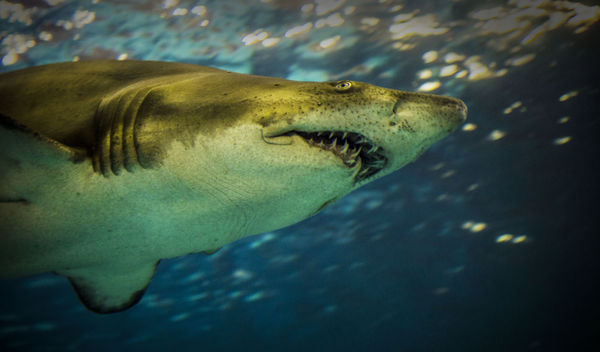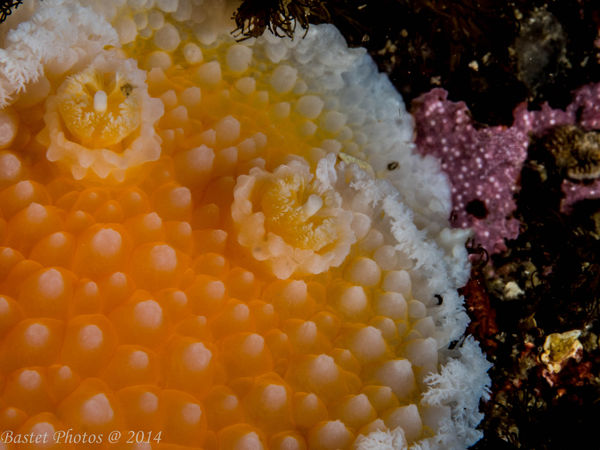Does anyone here do aquarium photography?
Jan 17, 2016 10:28:27 #
Bill_de wrote:
Very nice! Did you need a polarizer, or did the zoo did a real good job with their lighting?
I'm impressed!
I'm impressed!
Thanks. No polarizer. Just the lighting they used inside the aquariums. One trick is to pay attention to any glare that might be on the glass and move around until it's gone. It wasn't a problem though.
Jan 17, 2016 10:52:28 #
Set you lens against to to the aquarium glass to cut reflection.
I set my camera on to manual mode, no flash.
I set my camera on to manual mode, no flash.
Canon5DMIII, lens 24-70mm.focal L.60mm.F2.8 1/60 sec. Wb,A

Jan 17, 2016 10:54:59 #
There is not a lot written about aquarium photography. A cpl is essential. A rubber hood is nice. Flash gun can also be useful with a softbox and tilted at 45 degrees. Always shoot 90 degrees to the glass. Three things to consider about camera settings-- moving fish, moving water, and glass/water. I use these settings--auto ISO, auto WB, shutter speed 250, f5.6. Flash is fill or 1/16-1/32 intensity. The idea about flash is to bounce light up and into the tank instead straight on producing that ugly white mess. I have many aquium images in my galleries if you want to look.
Jan 17, 2016 11:25:40 #
Big Bill
Loc: Phoenix, AZ
Bill_de wrote:
With the lens flat against the tank (provided the ... (show quote)
:thumbup: :thumbup:
I have done a little with my own aquarium, and found off-camera flash to be best, as you describe.
Jan 17, 2016 11:58:37 #
Thanks for the tip about putting the lens directly against the glass to avoid glare. Assume this would be applicable to any through the glass with glare shot?
Bill_de wrote:
With the lens flat against the tank (provided the ... (show quote)
Jan 17, 2016 12:39:50 #
Wesley86 wrote:
I like to hear how you photograph fish and coral. Canmera settings and techniques and filters.
The obvious techniques have been suggested with great examples so far, so I will not belabor the point. Here are a couple of tips that are never really mentioned.
1. Public aquaria are great collector of children's fingerprints as they gawk at the aquatic specimens on display. Bring a small piece of cleaning cloth to wipe the surface of the glass before photos as well.
2. Stand in front of the display for a while. Fish are pattern sensitive and repeat their movements and choices of location on a regular basis. Scoping out where these are in the tank saves the time and frustration of attempting to chase the organism around the tank for a shot.
3. Visit your local pet shop. Managers are usually very willing to have you set up and shoot images. Especially if you choose to provide them with a copy image or two for their web site, etc. they have staff that can,and often do, clean the glass for you.
4. You would be surprised by how many friends and family members that may know of someone who has a nice tropical fish tank you can capture images from.
Good luck and we hope to see some of your results in the near future.
Jan 17, 2016 13:45:22 #
Bill_de wrote:
Very nice! Did you need a polarizer, or did the zoo did a real good job with their lighting?
I'm impressed!
I'm impressed!
These are very nice! Great job. I have also seen people use specialty plexiglass tanks that are very narrow and are meant to hold the fish in one position while the photographer shoots. I am usually in the water as a diver with a camera in a housing these are very very close. Might be nice to shoot with out having to SCUBA. Nice tips for shooting through glass. Here is what I am shooting underwater... nudibranchs. This is a macro shot.

Jan 17, 2016 15:24:56 #
i have taken some pictures of the aquarium.it is better not to use flash while taking pictures there.you might startle the fishes and the people who work in the aquarium do not appreciate you,using the flash. and using the flash might over expose your photos.you may have to increase the ISO between 1600 to 6400(you may have to play with different high ISOs till you get it right). a rubber lens hood might help so that you can press the camera against the glass to avoid glare or a polarized filer will also help.you need to use a wide aperture like f/2 to f/5.you set the white balace to auto and correct in your post processing,joseph
Jan 17, 2016 15:59:03 #
joseph premanandan wrote:
i have taken some pictures of the aquarium.it is better not to use flash while taking pictures there.you might startle the fishes and the people who work in the aquarium do not appreciate you,using the flash.
I think it best to check where you are shooting rather than make a blanket statement. When I first shot at an aquarium it was staff members, including their go to photographer, who said, grab your strobes.
I should have mentioned earlier, that some places, private and public, may let you come in early or stay a little late ... for a small donation.
--
Jan 17, 2016 16:40:52 #
You may find that adjusting levels will improve your pictures of aquariums greatly
Jan 17, 2016 16:41:49 #
You may find that adjusting levels will improve your pictures of aquariums greatly
Jan 17, 2016 16:46:57 #
i not making a blank statements.even if the staff members in the aquarium may not mind you using a flash(most of the times they do),the fishes and the other creatures live in water do! you do not want to startle or scare them for your selfish reasons of taking a picture of them.you might as well increase your ISOs. to accomplish your task,joseph
Jan 17, 2016 17:15:42 #
Here is a pretty good article on shooting an aquarium.
http://www.advancedaquarist.com/2012/7/photography
--
http://www.advancedaquarist.com/2012/7/photography
--
Jan 17, 2016 18:09:03 #
joseph premanandan wrote:
i not making a blank statements.even if the staff members in the aquarium may not mind you using a flash(most of the times they do),the fishes and the other creatures live in water do! you do not want to startle or scare them for your selfish reasons of taking a picture of them.you might as well increase your ISOs. to accomplish your task,joseph
Before this degrades to an argument instead of advice, I have shot for the Monterrey Bay Aquarium and this is basically their policy, and makes a fair amount of sense.
Most, if not all aquariums are "Low Light" observation platforms. Which means the subjects are lit and the outside has low light so the viewers are able to view the organisms without the extra glare from the surface of each tank. Specimens are then unable to see the people outside their environment.
No flash is recommended for two main reasons. Some exhibits will have a special sign designating no flash due to the species being represented is a "deep water" species unaccustomed to any light at all let alone a flash. In these cases, they want to restrict the light to the requirements of the species habitat.
The other reason for the resistance to flash is one of annoyance to all the viewers engaged in viewing each species. Since it is usually dark, human eyes have adjusted for the low light and the constant flash is annoying for the visitors more than the fish in the aquaria.
Utilizing available light is the best method when possible when shooting with many people viewing.
As for spooking the fish, that is not usually an issue. Almost all, if not most underwater shooting from divers use electronic flash without any known effects to the organism.
My suggestion would be to always talk to someone to gain permission or obtain restriction requirements. That is why, in a previous post, I suggested going to a local pet shop or finding someone with a tank of their own. It is more convenient, less busy, and you can concertrate on the photography and not people getting in the way. The fish, for the most part, don't care.
Jan 18, 2016 02:06:40 #
In addition to the techniques outlined by those who have already replied, you should also take a good cleaning cloth to polish off the greasy marks left on the glass by members of the public. I use a macro lens rather than a wide angle and press the lens hood up against the area I have just polished.
If you want to reply, then register here. Registration is free and your account is created instantly, so you can post right away.








